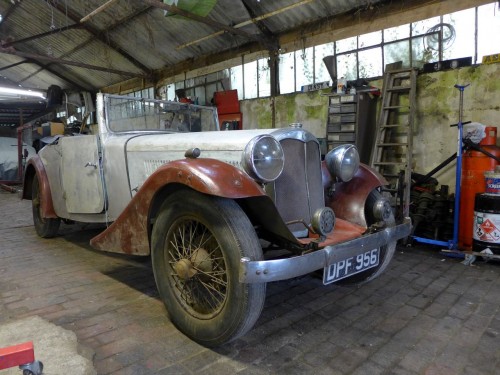
Click Here for Full Screen Image - Click Here to Download Image
 |  |  |  |  | |||||
 |  |  |  |  | |||||
 |  |  |  |  | |||||
 |  |  |  |  |
| Lot number | 26 |
|---|---|
| Hammer value | £7,400 |
| Description | AC 16/70 Two-seater Drophead Coupe |
| Registration | DPF 956 |
| Year | 1936 |
| Colour | Aluminium |
| Chassis No. | L382 |
| Engine No. | N/A |
One of the oldest names in British motoring history, AC can trace its origins right back to 1901 and specialised in producing three-wheeled delivery vehicles up to the outbreak of the First World War.
After the war AC came out with a new two-litre overhead-cam six-cylinder engine which was to remain in production until 1963, making it the second longest-lived production engine in history after the VW boxer.
Powerful and reliable, the two-litre 16hp engine was fitted to a range of taut-handling sports and touring cars that cemented AC’s reputation amongst keen drivers and won the firm many laurels on the track. Launched in 1936, the 16/70 model boasted triple SU carburettors and a class-leading 70bhp, sufficient for a top speed of 84mph.
Available with a choice of open and closed factory coachwork, it was a quality machine in all respects and cost a third more than the equivalent SS Jaguar. Just 587 AC 16hp models of all types were produced in total and survivors are keenly sought after today.
As a letter from the AC Owners' Club in the history file confirms, this particular 16/70 Two-seater Drophead dates from January 1936 and was first owned by HB Wakefield Esq of Sedgwick House, Sedgwick, Cumbria. Originally metallic blue with a red leather interior, DPF 956 was fitted with a 16/70 Sports engine (number UBS 61/2 329). It is not certain how long Wakefield kept the car but the next owner was Commander Colin Gatey RN of Bexhill-on-Sea (HMS Basham) who, in turn, passed the car on to Lt Col Anthony Yorke of RN Barracks, Chatham, Kent.
By 1968 an old green log book shows that the car was in the possession of Philip Kelly of Wigan who was to keep it for over 40 years, finally selling it to the current owner in 2009. It would appear that Kelly never used the car but kept it in storage, although it was definitely on the road in 1963 and 1967 as two old MOT certificates confirm. Another letter in the history file indicates that the car had been fitted with a pre-war Jaguar 1.5-litre engine in 1966, this unit being still in place when the current owner acquired the car.
A long-standing AC enthusiast, he set about dismantling the car with the intention of restoring it to its former glory, the whole process being recorded in photographs. With the body completely removed, the chassis was then sandblasted, repaired as necessary and painted. A new fuel tank was also made and various other jobs attended to at which point events took an unexpected turn when an AC Aceca that the vendor had long been trying to acquire suddenly became available.
With insufficient time and resources to tackle two projects, he has now reluctantly decided to part with the 16/70 in order to concentrate on the Aceca. The 16/70 has thus been loosely reassembled for ease of transport but many items (including the dash instruments and the gearbox) remain detached and will need to be re-fitted at a later date. The hood frame and sidescreens are still present but the sidescreens have no glass.
The 1.5-litre Jaguar engine has been removed and is included in the sale, but it was the vendor's intention to fit a post-war AC two-litre engine and gearbox which he had acquired some years earlier. These will be made available to the winning bidder by separate negotiation if desired. He suggests that a Triumph 2000 six-cylinder engine may also be quite a good fit as an alternative.
The car comes with the aforementioned documents and photographs plus a picture of it when it was still in use with a former owner in the early 1960s and a current V5C. With good examples now fetching well in excess of £30,000 at auction (Brightwells sold one such in March 2012), this rare and rakish machine should amply reward the further restoration that it still requires.